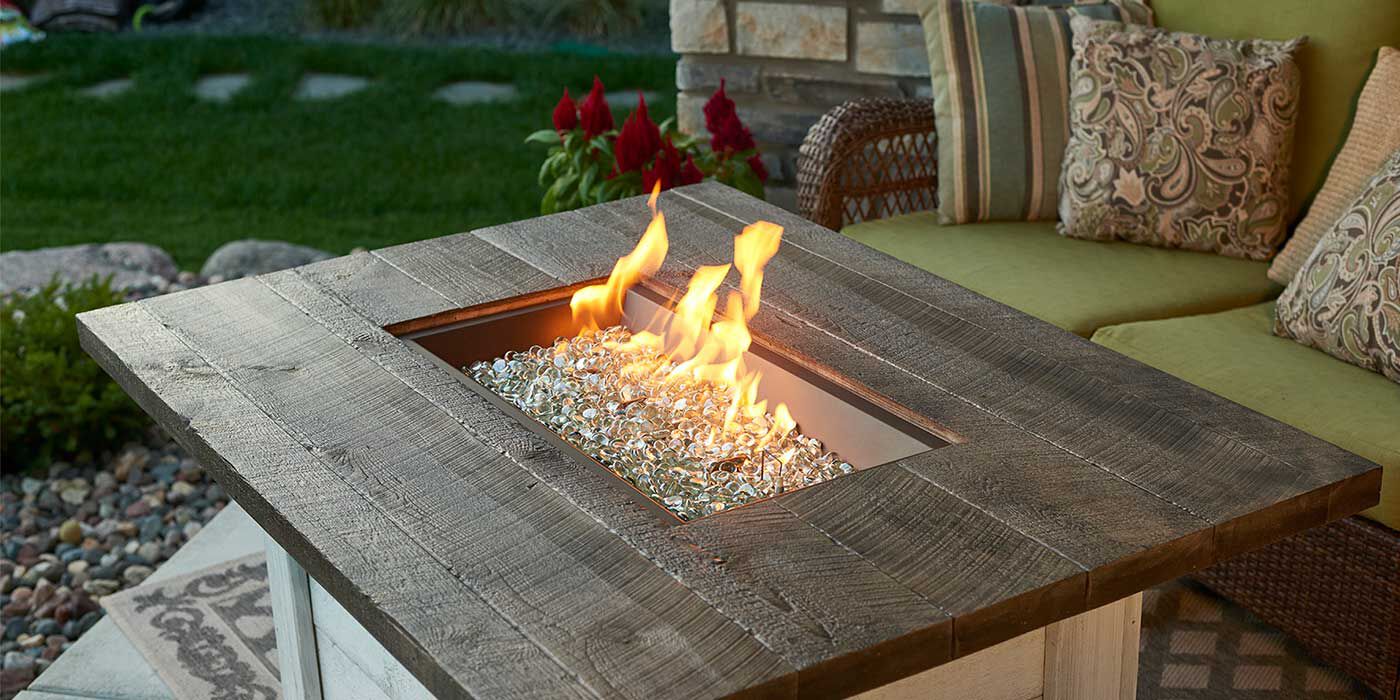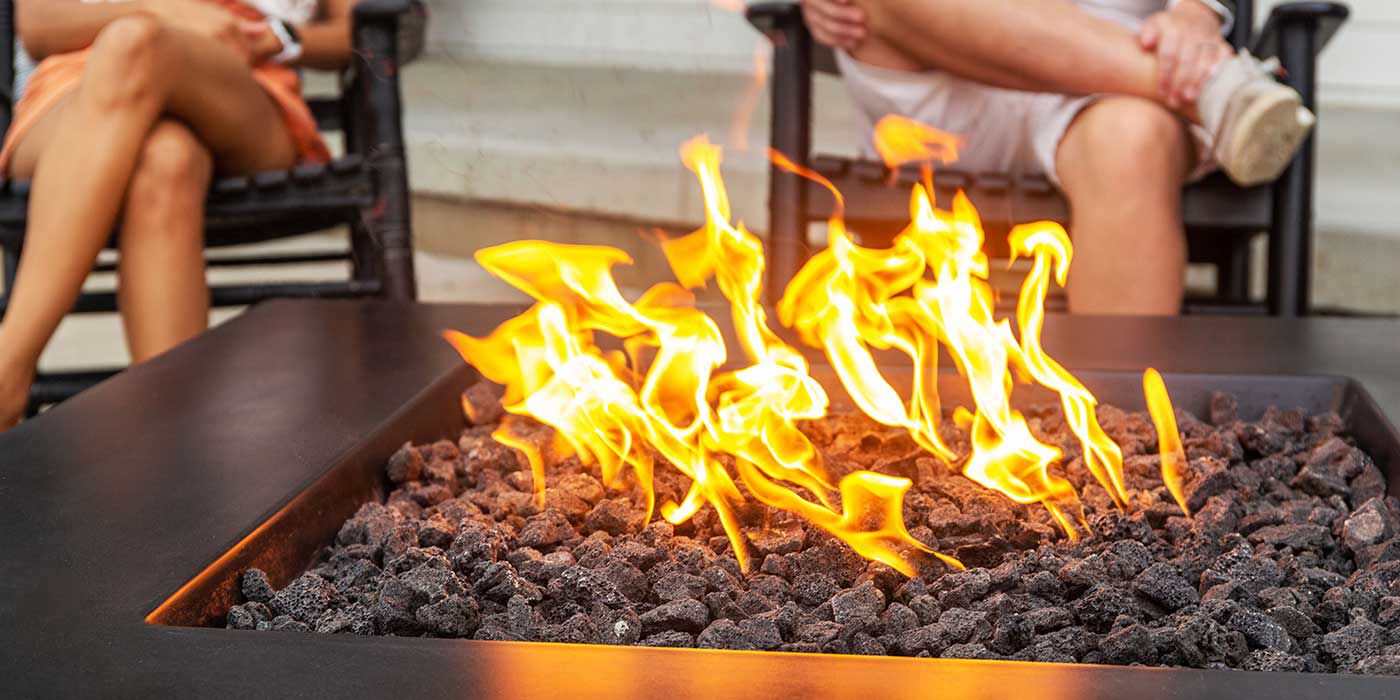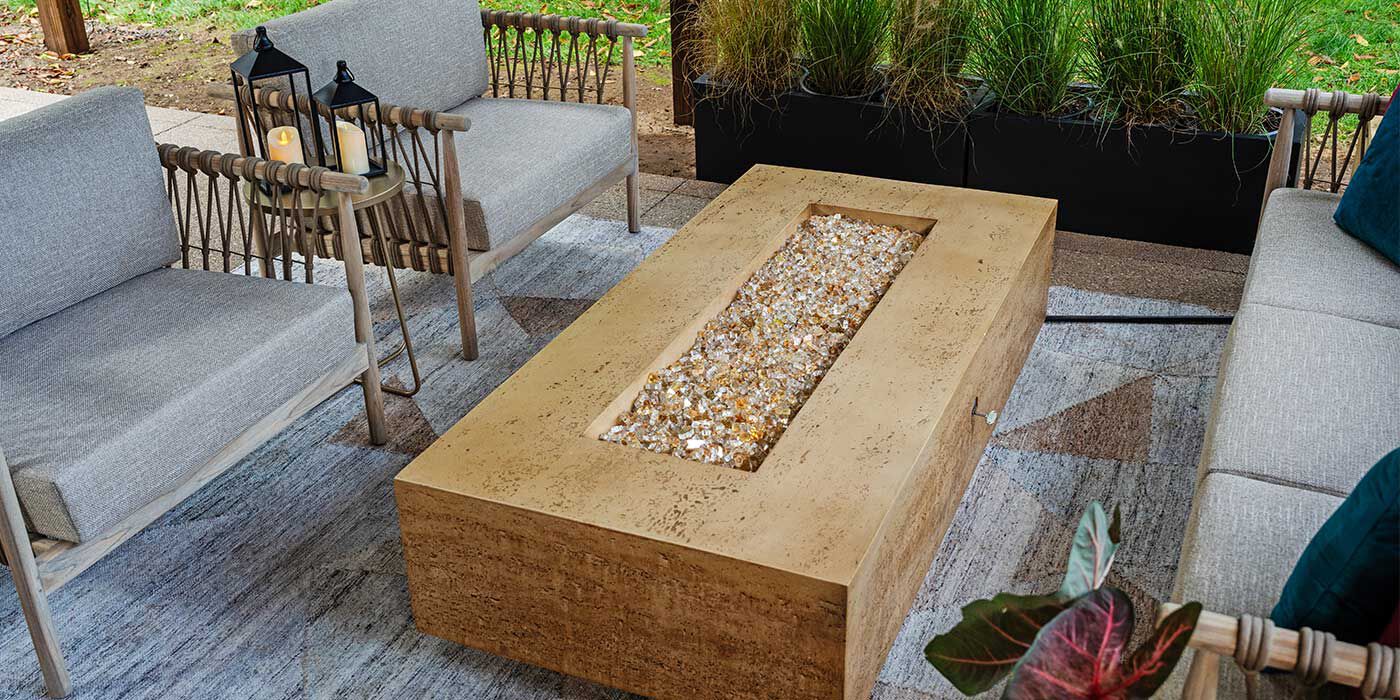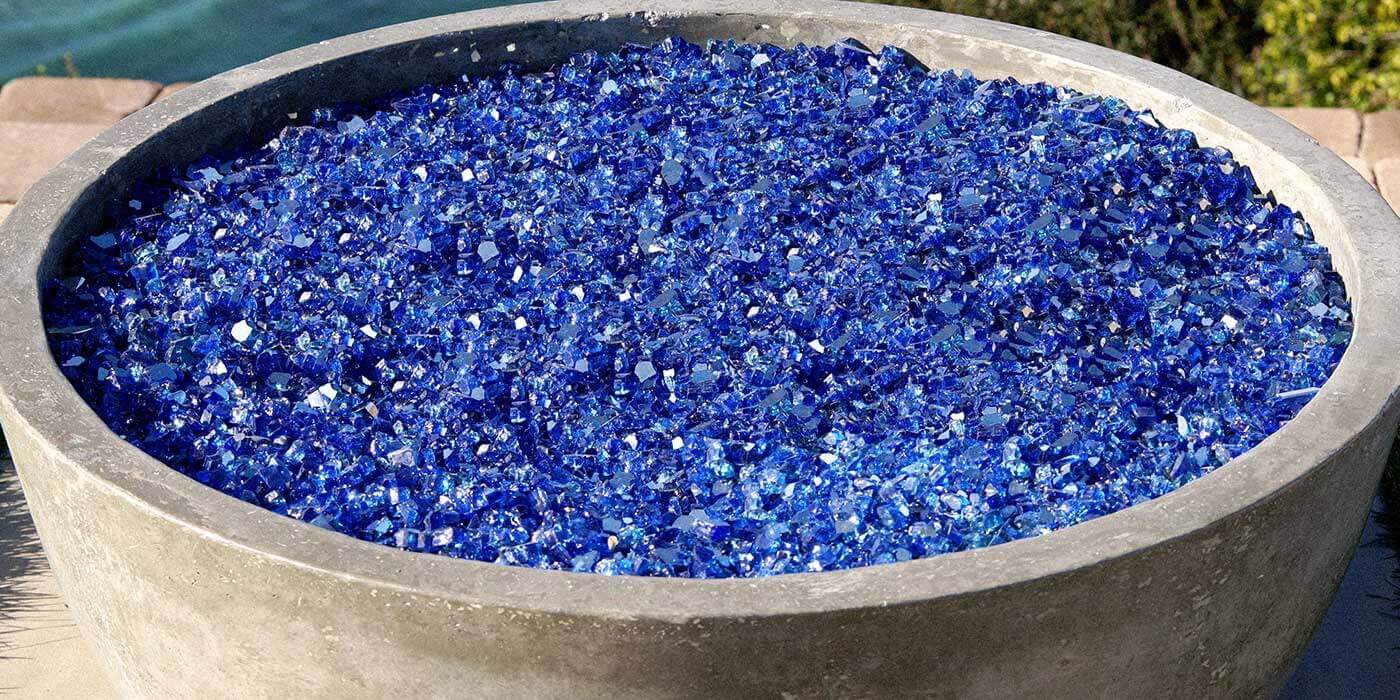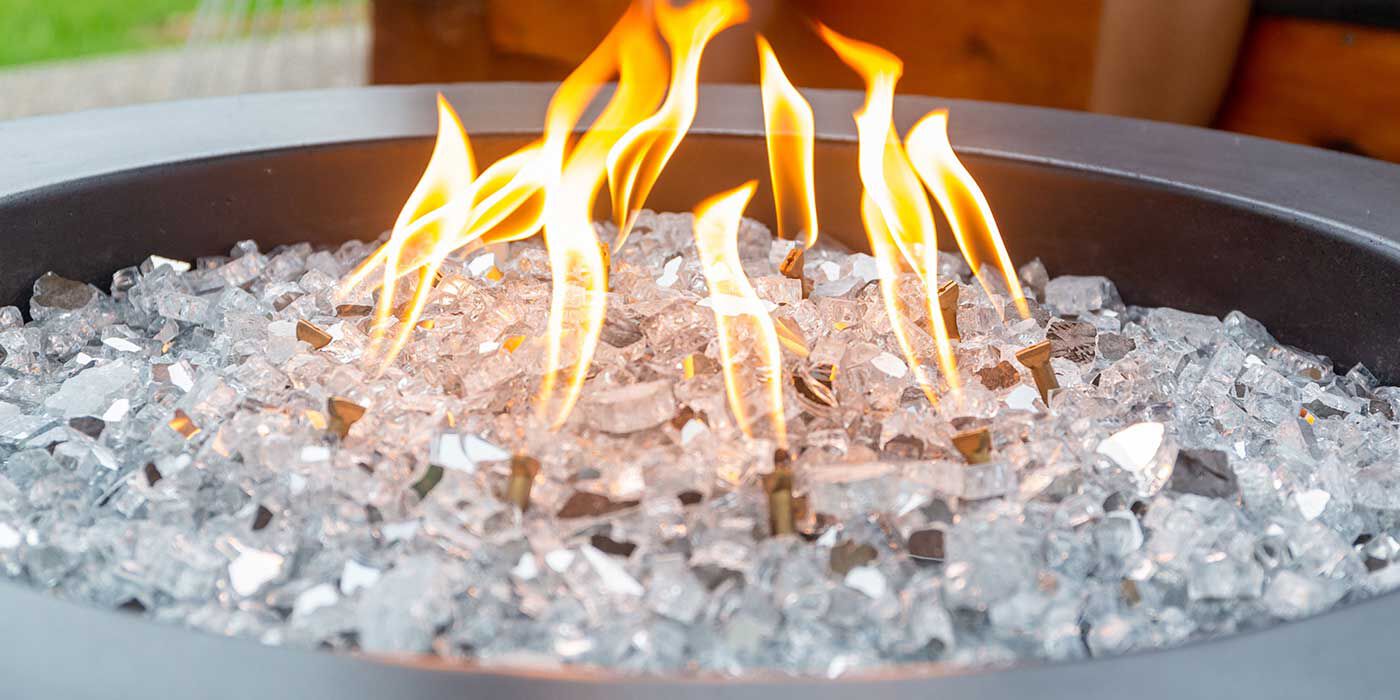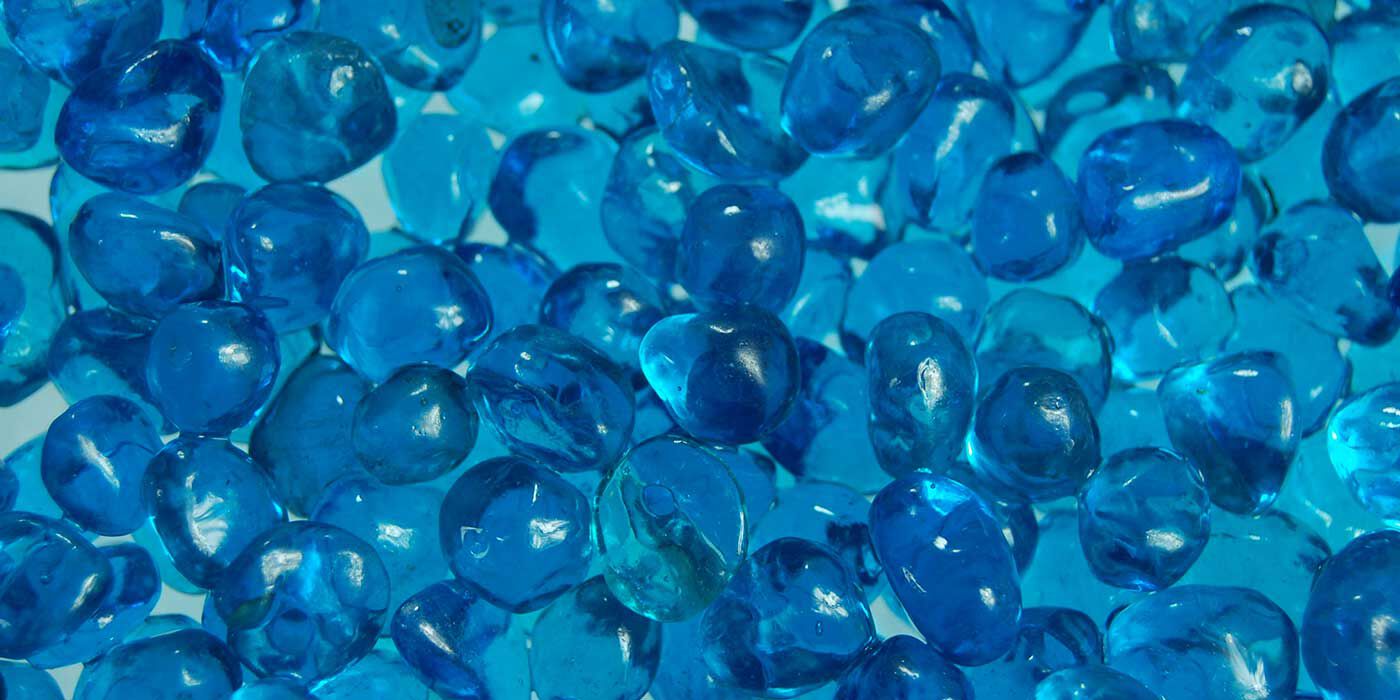By: Garrett Jamieson, NFI Certified Master Hearth Professional
Last Updated: March 7, 2025
No matter what gas fire pit you purchase, it needs media. Sometimes referred to as “fire jewelry,” media plays an essential role in how your outdoor fire pit looks and performs.
Media comes in a variety of materials, colors, shapes, and sizes, allowing you to customize the look of your fire pit to match your outdoor living space.
Two of the most popular media types are fire pit glass and lava rock. In this article, we’ll explore the benefits of both, so you can find the perfect finishing touch for your fire pit.
Why Do You Need Fire Media?
Fire pit media is essential for all gas fire pits. It helps create a natural flame appearance and fire ambiance.
If you use a gas fire pit burner without media, the flames will concentrate in certain areas. Media disperses the gas throughout the entire burner area, resulting in a robust and realistic flame presentation. Media also conceals your burner, creating a more streamlined look for your fire pit.
There's a variety of fire media available, from traditional lava rock to contemporary fire glass and rustic log sets.
Pro Tip:
DO NOT use regular stones or river rocks in your gas fire pit. Regular stones may contain water that, once heated, will produce a build-up of steam, and cause the stones to explode.
How Much Media Do You Need?
Typically, with proper gas pressure, media should only cover your gas fire pit burner by 1 inch.
Media placement varies depending on the burner. Be sure to check your owner's manual to determine the proper media amount and depth.
For example, burners with raised jets, like the Torpedo or Bullet Burner, must have the jets exposed. Only cover the burner tube with media and leave the jets visible. Media can sit flush with the jets, or they can stick out a little above the media.
What is Lava Rock?
Lava rock is an organic material naturally formed from volcanic magma. As the magma cools, trapped gases burst through the surface, creating lava rock’s signature porous look.
Lava rock is completely fire safe, maintenance-free, and can withstand long-term exposure to high temperatures. Many homeowners also use lava rock as a base for more expensive fire media to save money.
The size, shape, and color of lava rock varies from batch-to-batch. If you want to achieve a more uniform look for your fire pit, it's best to buy lava rock media in bulk up-front.
Pro Tip:
If you’re looking for a more contemporary version of traditional lava rock, we carry tumbled lava rock (rolled lava stones). While it’s still durable and porous with heat-retaining properties, tumbled lava rock features a smooth, uniform finish that’s perfect for modern fire pits.
How to Put Lava Rock in Your Gas Fire Pit
First, read through your fire pit installation manual to determine how much lava rock you need. Always wear a pair of sturdy outdoor gloves while handling lava rock to avoid cutting your hands.
Pour the lava rock out onto the ground to remove any dust particles and separate the broken pieces. Extra dust can clog your burner system and negatively impact its performance.
Pick up individual pieces of lava rock and place them into your fire pit. Start with the smaller pieces for the first layer, adding larger pieces on top as you go.
Using Lava Rock as a Base Layer for Other Media
Follow steps 1-2 above, but this time only fill the lava rock up 3/4 of the way.
Top off your media bed with a layer of fire glass or river rocks.
What to Do If Your Lava Rock Gets Wet
Lava rock is a porous material and easily absorbs water. If you turn your fire pit on high while the lava rock is wet, the water inside will boil. This can cause the lava rock to pop or potentially burst.
Here’s what to do to use your fire pit safely if your lava rock is wet:
- Turn the fire pit on low for 15-30 minutes. This will safely burn off any water (If you live in a naturally humid area, you may need more time).
- Once the fire pit has been on long enough for the lava rock to dry, slowly turn the gas up to adjust your flame height.
Keep Your Gas Fire Pit Covered
One way to prevent your media from getting wet is to keep your fire pit covered when not in use. Covering your fire pit also prevents unnecessary damage from daily exposure to the elements.
In some cases, not using a cover may even void the warranty of your burner. If possible, you can always store your fire pit away during the winter or off-season to keep it safe from harsh weather conditions.
Make sure your fire pit is cool to the touch before covering; otherwise, the cover may melt and ruin the burner.
What is Fire Pit Glass?
Fire pit glass is colored-infused tempered glass. Tempering is a process that increases the strength of glass through heating and quickly "quenching," or cooling, the glass. Certain chemical processes also create tempered glass.
Both processes create compression on the glass surface and tension inside. The result is glass that's four times stronger than un-tempered glass.
Fire glass pieces undergo a tumbling and polishing process, removing sharp edges, and making them safe to handle. They can handle high-heat applications without discoloring, burning, melting, or producing toxic fumes. Fire glass also doesn't produce soot, ash, or smoke when used properly.
One of the biggest benefits of fire pit glass is that it generates a tremendous amount of heat. It radiates 3-4 times more heat than gas logs and lava rock with its reflective surface, making it more efficient for warming your space.
Another benefit is the modern look of the glass and the variety of colors you can choose from.
Pro Tip:
DO NOT use regular, un-tempered glass in your fire pit. Regular glass can pop or burst in extreme heat, sending sharp shards flying.
Types of Fire Pit Glass
Accent Fire Pit Glass
Accent fire glass features small, non-uniform pieces of glass chipped from larger glass bricks, then tumbled and polished.
We recommend using accent fire glass on top of larger fire glass pieces. You can use a single color or mix and match accent fire glass colors to complement your outdoor decor.
Reflective Fire Pit Glass
Reflective fire glass features a mirror-like finish and intensified coloring. Both sunlight and flames dramatically reflect off the mirror-like surface for a gorgeous display both day and night.
Smooth Fire Pit Glass
Smooth fire glass consists of smaller, irregularly sized glass pieces with polished edges that resemble marbles or jellybeans. The coloring is consistent throughout with a slightly translucent finish.
Fire Pit Glass Tips
Compared to lava rock, fire glass can get expensive, depending on how much you need for your fire pit.
You can use lava rock as a base layer and place fire glass on top to save some money and still achieve an upscale look. However, keep in mind that lava rock will cause some soot to build up on your fire glass. Using Propane as your fuel source may also result in some soot.
To avoid a sooty appearance, choose darker colored fire glass. If you go with a lighter color, you will need to clean your fire glass occasionally to remove any built-up soot and debris.
Instead of lava rock as a base layer, you can also add a generous layer of less expensive, clear fire glass. Then, top off the clear fire glass with your choice of colored fire glass. This won’t reduce the cost as much as using lava rock, but it will prevent soot build-up and save you from having to clean your fire glass.
How to Clean Fire Pit Glass
Fire glass can break, so make sure you wear gloves during the entire cleaning process to protect your hands from sharp shards:
Remove the fire glass from the fire pit and place it into a bucket of soapy water, washing it clean. Rinse off the glass with soap and clean water, then spread the pieces out on a towel to dry.
Once the fire glass pieces are completely dry, carefully place them back into your fire pit.
Lava Rock & Fire Pit Glass Safety Tips
- Fire glass and lava rock are only safe for gas fire features fueled by Propane or Natural Gas.
- It is not safe to place another type of media on top of fire glass.
- The bottom layer of your fire media radiates heat even after you turn your fire pit off. Be sure to wait until your media is completely cool before handling it and always wear a pair of gloves to protect your hands.
- While your fire glass may have some soot build-up, an excessive amount may indicate that your air mixture is incorrect. Soot build-up is never a result of your fire media. You should contact your installer to verify that your fire pit is burning cleanly and efficiently.
- Make sure your gas fire pit has proper ventilation on at least two sides. Trapped heat can crack or melt your fire glass. Contact your installer right away if ventilation or heat build-up is a concern.
- Keep your fire pit covered when not in use to prevent moisture from getting inside. When water or condensation heats up in your fire pit, it causes a buildup of steam that can impact your fire pit's performance. Steam can also affect your media, causing porous lava rock to pop or burst.
- If dropped, fire glass has the potential to crack or fracture, creating sharp edges. Always use caution when handling your media and be sure to wear a sturdy pair of gloves.
We're Here to Help
Do you have more questions for us? Call our NFI certified experts at (800) 919-1904 today!
More Resources
Follow this easy guide to build your ultimate DIY fire pit from scratch!
Save time and money with these simple do-it-yourself fire pit kits.
Here are the top tips you need to know to keep your fire pit burning for years to come.
Frequently Asked Questions
What fire pit glass and lava rock brands do you carry?
- American Fireglass
- Arctic Flame
- Firegear
- Grand Canyon Gas Logs
- Grand Canyon Outdoor
- HPC
- Krystal Fire
- Northern Flame
- Uniflame
Can I use lava rock and fire pit glass together?
Yes, you can mix lava rock and fire pit glass. For a cost-effective solution, you can use small lava rock as a base layer to insulate the burner, then add fire glass on top.
Are there other fire pit media options available?
Yes! You can choose from much more than traditional black lava rock and fire glass. There’s a variety of media options to achieve the perfect look for your gas fire pit. Some of the most popular media styles include outdoor gas log sets, rolled lava stones, firestones, fireballs, and decorative metal shapes.
Ceramic logs create a classic, campfire feel, without all the work that goes with a real wood burning fire pit. Fireballs and metal fire shapes transform you fire pit into an artistic accent piece that sparks conversation.
Take a closer look at all the available fire pit media types with our in-depth buying guide.
 |
Garrett Jamieson has been a Technical Sales Representative at Woodland Direct for over a decade. As an NFI-Certified Master Hearth Professional, he's well versed in fire products and safety standards. He strives to help clients understand product features and best installation practices, so they can find products that fit their home and lifestyle. Outside of work, Garrett spends most of his time outside, riding bikes, bowling, camping, grilling, chopping wood, and tackling DIY projects with his family. Call him or one of our experts in fire at 800.919.1904. |
